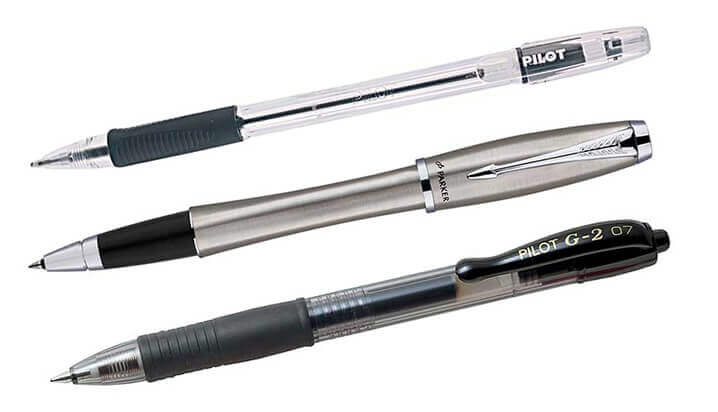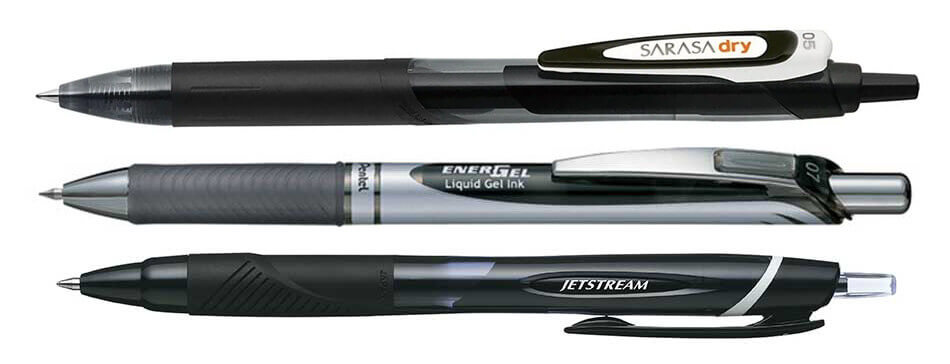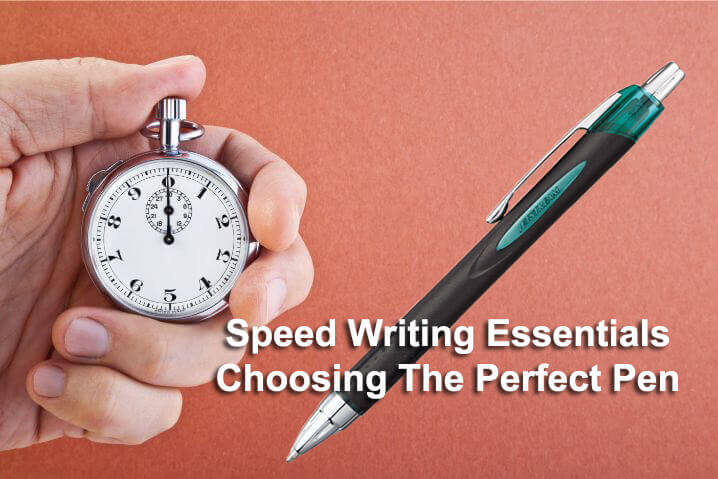Speed writing is a valuable skill that can save time and improve efficiency in today’s fast-paced world.
Whether you’re a student taking notes, professional attending meetings, or a writer brainstorming ideas, the right pen can make all the difference.
In this article, we’ll explore the factors to consider when selecting a pen for fast handwriting and recommend the best pens to enhance your speed writing experience.
Table of Contents
1. Components of a Pen

A pen may seem like a simple writing instrument, but its performance has several critical components.
Understanding these components and their functions can help you make an informed decision when choosing the perfect pen for speed writing.
Barrel
The barrel is the pen’s main body. It houses the ink reservoir and provides structure.
Material
Manufacturers can make pen barrels from plastic, metal, or wood, impacting the pen’s weight, sturdiness, and appearance.
Lighter materials, like plastic are usually more comfortable for long writing periods, while heavier materials, like metal, can give the pen a higher-quality feel.
Design
Some pen barrels are cylindrical, while others have a hexagonal design that prevents the pen from rolling off a table.
The barrel’s design can also include features like a built-in clip for attaching the pen to a notebook or pocket.
Grip
The grip is the lower section of the pen; often, designers create the area where you hold it with ergonomics in mind.
Material
Grips can be made of rubber, silicone, or textured plastic, providing added comfort and reducing the chances of the pen slipping while writing.
Some pen grips also include contours or indentations that promote a proper grip for better control and reduced hand fatigue.
Size
The grip’s size is also crucial for comfort during extended writing sessions.
A grip that is too small or too large can cause hand strain, so finding a pen that suits your hand size is essential for speed writing.
Nib or Tip
The nib or tip is where the pen makes contact with the paper delivering the ink and is responsible for ink flow and line width.
Nib (Fountain Pens)
Manufacturers create fountain pen nibs in various sizes and shapes from metal, typically gold or stainless steel.
The size and shape of the nib determine the line width and writing style, with options like fine, medium, and broad nibs available.
Specialist nibs with flex or stub characteristics also allow for varying line widths and expressive writing.
Tip (Ballpoint, Gel, and Rollerball Pens)
The tips of these pens are usually made of metal or ceramic, with a small ball bearing that rolls as you write, dispensing ink onto the paper.
The size of the ball bearing and the tip’s design can affect the writing experience’s smoothness and the line width produced.
Ink Type
The type of ink that a pen uses can have a significant impact on writing speed and style.
Ink formulation
Different types of pens use different ink formulations, such as oil-based ink (ballpoint pens), water-based or gel ink (gel and rollerball pens), or liquid ink (fountain pens).
The ink’s formulation can influence the writing experience, drying time, and resistance to smudging or fading.
In our article Ballpoint vs. Roller Ball vs. Gel Pens, we discuss the different ink types and the pros and cons of each pen type in detail.
2. How The Pens Components Affect Writing Speed
The various components of a pen can either enhance or hinder your writing speed.
Each component ensures a smooth, efficient, and comfortable writing experience.
Here’s a closer look at how the different parts of a pen can impact writing speed:
Grip Section
A well-designed grip is essential for maintaining control and stability while writing, ultimately affecting your writing speed.
A comfortable grip reduces hand fatigue and prevents cramping, allowing you to write for extended periods without losing efficiency.
Ergonomic grips with contours or indentations encourage proper hand positioning, promoting better control and faster writing.
Nib or Tip Size
The size of the nib (for fountain pens) or the tip (for ballpoint, gel, and rollerball pens) can significantly impact your writing speed.
A fine nib or tip may provide more precision but can also cause increased friction on the paper, slowing down your writing.
On the other hand, a broader nib or tip can create a smoother, more fluid writing experience, which can contribute to increased writing speed.
Finding the right balance between precision and smoothness is essential for maximizing writing efficiency.
Ink Type
The type of ink a pen uses can also affect writing speed.
Some ink formulations dry faster than others, which can help prevent smudging and allow you to move quickly across the page.
For example, oil-based ink in ballpoint pens dries faster than water-based or gel ink in rollerball and gel pens.
Fountain pen ink can vary in drying time depending on the specific formulation.
Smudge Resistance
Inks resistant to smudging, such as quick-drying or waterproof, can help improve writing speed by reducing the need to pause and wait for the ink to dry.
It is essential for left-handed writers who may be more prone to smudging as their hand moves across the page.
Check out our Guide, The Best Pens for Left Handers, where we go into much more detail.
Pen Weight and Balance
The overall weight and balance of a pen can also influence writing speed.
A too-heavy pen may cause hand fatigue and slow your writing, while a too-light pen might lack stability and control.
Finding a pen with the right weight and balance for your hand can help you maintain a comfortable and efficient writing speed.
Ink Flow
The consistency of ink flow is another factor that can impact writing speed.
Pens with a consistent and smooth ink flow enable you to write without interruption, while pens with inconsistent ink flow may cause skips or require you to go back and rewrite words, slowing you down.
A pen with a reliable ink flow mechanism can help ensure your writing remains fluid and efficient.
Understanding how a pen’s various components affect writing speed is essential for choosing the perfect pen for speed writing.
A well-designed grip, an appropriate nib or tip size, the right ink type, and proper pen weight and balance can all contribute to a faster, smoother, and more efficient writing experience.
3. Pen Types And Their Impact On Speed Writing

Ballpoint Pens
Ballpoint pens are the most common, featuring a small rotating ball at the tip that dispenses ink as you write.
They use oil-based ink, which dries quickly and is less likely to smudge.
These pens have been a staple in writing instruments for their practicality and reliability.
Advantages For Speed Writing
Quick-Drying Ink
Ballpoint pens use oil-based ink, which dries faster than other types of ink.
This feature helps reduce smudging, particularly for left-handed writers or when writing quickly.
Consistent Ink flow
Ballpoint pens typically offer constant ink flow, ensuring you can write smoothly and continuously without dealing with ink skipping or running out.
Widely Available and Affordable:
Ballpoint pens are the most common and available at various prices, making them accessible to everyone. However, their affordability means you can always have a reliable pen for speed writing.
Disadvantages For Speed Writing
Ink Clumping or Skipping
Some ballpoint pens may experience ink clumping or skip due to the thicker nature of oil-based ink. This issue can cause interruptions in your writing, affecting your speed and efficiency.
Heavier Writing Pressure
Ballpoint pens often require more writing pressure than other pen types.
This additional pressure may cause hand fatigue during extended writing sessions, slowing your writing speed.
Ballpoint pens can be an excellent choice for speed writing due to their quick-drying ink, consistent ink flow, and wide availability.
However, it’s essential to consider potential drawbacks, such as ink clumping or the need for heavier writing pressure.
Gel Pens
Gel pens use water-based gel ink that provides a smooth and consistent writing experience.
The ink has a greater volume due to the combination of the gel particles suspended in the water solution.
It is more vibrant than a ballpoint pen, making them popular among artists, calligraphers, and writers.
Advantages For Speed Writing
Smooth and Consistent Ink Flow
Gel pens offer a smooth and consistent ink flow, ensuring your writing experience is seamless and uninterrupted.
This feature is beneficial when writing quickly, allowing you to maintain momentum.
Requires Less Writing Pressure
Gel pens generally require less writing pressure than ballpoint pens, which can help reduce hand fatigue during extended writing sessions.
This feature allows you to maintain your writing speed without experiencing discomfort.
Disadvantages For Speed Writing
Longer Drying Time
Due to the water-based nature of gel ink, it can take longer to dry than oil-based ink.
This longer drying time may lead to smudging, particularly for left-handed writers or when writing quickly.
Ink May Run Out Faster
Gel pens use ink more quickly than other pen types due to their thicker ink consistency. As a result, you may have to replace the ink cartridge or pen more frequently.
Gel pens can be an excellent option for speed writing due to their smooth ink flow, vibrant colors, and reduced writing pressure.
However, it’s essential to consider potential drawbacks, such as longer drying times and more frequent ink replacements.
Rollerball Pens
Rollerball pens are similar to ballpoint pens but use water-based ink.
They offer an exceptionally smooth writing experience, making them a popular choice for many writers.
Advantages For Speed Writing
Smooth Writing Experience
Rollerball pens provide a smooth and fluid writing experience similar to that of a fountain pen. This feature allows for a more comfortable writing experience and helps maintain a consistent writing speed.
Fast Flowing Ink
The water-based ink in a rollerball pen is the fastest flowing of all the different ink types allowing the ink to be put down quickly on the paper’s surface.
Disadvantages For Speed Writing
Longer Drying Time
Rollerball pens use water-based ink, which may take longer to dry than the quick-drying ink in ballpoint pens.
This longer drying time can lead to potential smudging, especially when writing at a fast pace.
More Frequent Ink Refills
Due to their water-based ink, rollerball pens may require more frequent ink refills than ballpoint pens, which can be inconvenient for those who write extensively.
Not as Widely Available as Ballpoint or Gel Pens
Rollerball pens may not be as readily available as other pen types, such as ballpoint or gel pens, limiting your options when looking for the perfect pen for speed writing.
Rollerball pens can be an excellent choice for speed writing due to their smooth writing experience and vibrant colors.
However, it’s essential to consider potential drawbacks, such as the longer drying time, the need for more frequent ink refills, and limited availability.
Fountain Pens
Fountain pens, featuring a nib and an ink reservoir, provide a unique and elegant writing experience.
While they require a more delicate touch and have a steeper learning curve, they offer several benefits for speed writing.
Advantages For Speed Writing
Smooth Writing Experience
Fountain pens are known for their smooth and fluid writing experience.
The ink flows seamlessly from the nib to the paper, allowing for a comfortable and efficient writing process.
Customizable Nibs and Ink Options
Fountain pens offer a wide range of nib sizes and styles, from extra-fine to broad, enabling you to choose the one that best suits your writing preferences.
You can also select from various ink colors and properties, allowing for further customization.
Can Improve Handwriting Style
A fountain pen can help improve handwriting, encouraging a lighter touch and more controlled hand movements. This improved handwriting can translate into faster writing speeds over time.
Some schools encourage children to use fountain pens, as discussed in Do Fountain Pens Improve Children’s Handwriting?
Disadvantages For Speed Writing
Steeper Learning Curve
Fountain pens may require some time and practice to master, especially for those accustomed to using ballpoint or gel pens.
This learning curve may initially slow your writing speed until you become comfortable with the pen.
Maintenance
Fountain pens require more maintenance than other pen types, such as regular cleaning and refilling.
This added maintenance can be time-consuming and may detract from your writing efficiency.
Potential for Ink Spills and Leakage
Due to their design, fountain pens are more susceptible to Ink spills and leakage, which can be inconvenient and disruptive to your writing process.
Longer Drying Time
A fountain pen’s water-based ink is very wet when first applied to the paper; therefore, more care is required to prevent smudging as the ink takes longer to dry than ballpoints or gel pens.
Fountain pens offer a unique and smooth writing experience that can enhance your speed writing once you’ve mastered their use.
Check out our Guide 10 Reasons Why Fountain Pens are Better Than Ballpoints to see why we are great fans.
However, it’s essential to consider potential drawbacks, such as the steeper learning curve, increased maintenance, and susceptibility to ink spills.
Hybrid Ink Pens
Hybrid ink pens combine the best features of ballpoint, gel, and rollerball pens to create an optimal writing experience.
These pens use a unique formula that balances the quick-drying properties of oil-based ink with the smoothness of water-based ink.
As a result, hybrid ink pens have become popular among writers looking for the perfect pen for speed writing.
Advantages For Speed Writing
Smooth Ink Flow
Hybrid ink pens offer a smooth and consistent flow similar to gel and rollerball pens.
This feature ensures a seamless and uninterrupted writing experience, allowing you to maintain your writing momentum.
Quick-Drying Ink
The unique ink formula of hybrid ink pens dries quickly, reducing the likelihood of smudging during fast-paced writing sessions.
This feature is particularly beneficial for left-handed writers or those who need to write rapidly without the risk of smudging.
Requires less writing pressure Like gel and rollerball pens, hybrid ink pens generally require less writing pressure than ballpoint pens.
This reduced pressure can help prevent hand fatigue during extended writing sessions, allowing you to maintain your writing speed comfortably.
Disadvantages For Speed Writing
Ink May Run Out Faster
Due to their unique ink formula, hybrid ink pens may use ink more quickly than other pen types, such as ballpoint pens.
As a result, you may have to replace the ink cartridge or pen more frequently.
Limited Availability
Hybrid ink pens are not as widely available as other pen types, such as ballpoint or gel pens.
This limited availability may restrict your options when searching for the perfect pen for speed writing.
Hybrid ink pens can be excellent for speed writing due to their smooth ink flow, quick-drying properties, and reduced writing pressure.
However, considering potential drawbacks, such as faster ink consumption and limited availability, is essential.
4. The Three Best Pens for Fast Handwriting

In our fast-paced world, having the right tools to enhance your handwriting speed can make all the difference.
With numerous pens on the market, finding the perfect one for speedy writing can be challenging.
Check out our top three Pentel, Uni-Ball & Zebra recommendations in our guide, The Best 3 Pens for Fast Handwriting.
Each pen is smooth writing, quick drying, with excellent performance. We’ve got you covered whether you’re after premium quality or budget-friendly options.
5. Conclusion
Choosing the perfect pen for speed writing ensures a smooth, efficient, and comfortable writing experience.
If you are a student or need to take notes quickly in a business meeting, check out our guide on the Top 5 Techniques for Taking Notes Quickly.
Understanding the various components of a pen and their impact on writing speed will help you.
The right pen is only one part of the process of writing faster. Check out our guide on How To Write Faster and Neater In 6 Simple Steps to take your writing speed to the next level.Top of Form
